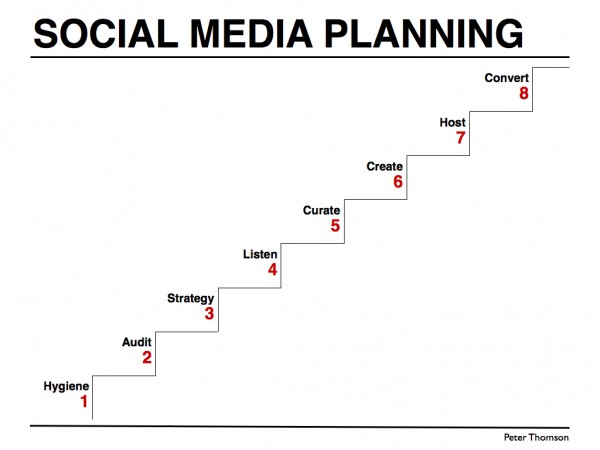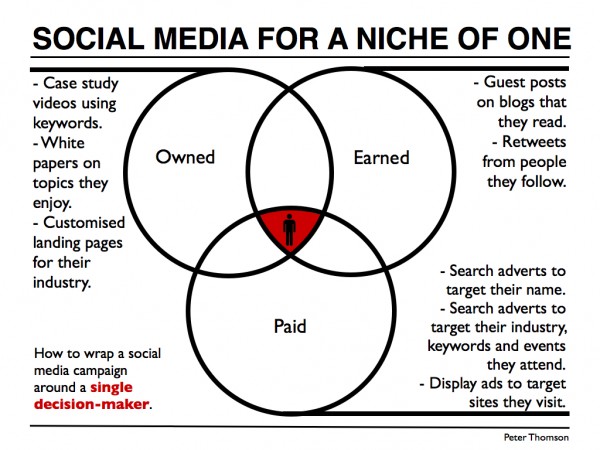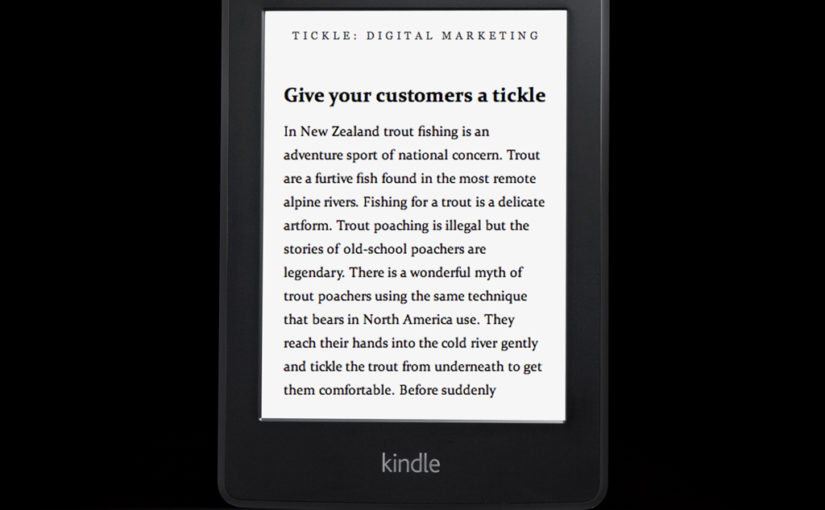Too many social media professionals don’t understand how to market to a cynical business audience. They get lulled into a false sense of security because many B2B (business-to-business) sales look just like B2C (business-to-consumer) sales. After all, we’re all people. But really hardcore B2B marketing (to large, unsexy, enterprise clients) is a whole different ball game. Really serious businesses have long and complex sales-cycles involving multiple decision-makers and even a formal “business case” for your product.

A good B2B Social Media Book would have lots practical examples from unsexy industries and be grounded in rigorous business strategy. I’ve been working on the book to bring together the best of the marketing industry’s knowledge on enterprise scale B2B social media.
A lot of the techniques and tricks are simply a digital update of old-school sales tools from companies like IBM, Oracle, Cisco, Siemens and General Electric. B2B social media should be years ahead of B2C, because of the long-standing appreciation of the importance of personal relationships. But it’s not.My book is a practical social media strategy book for practitioners working inside big companies (and startups that sell to big companies). It’s also a book for practitioners to share with cynical managers to bring them up to speed on why social media is so important to serious companies.
Audience
For many B2B sales executives inside big technology companies, social media is a daunting new world. Even professional B2B marketers who keep up with social media trends may have missed some of the new ways that social media can be used by B2B companies. It’s time for an instruction manual on the use (and abuse) of social media by B2B sales mercenaries. The book is aimed at senior managers who can set the company’s social media strategy or those who don’t yet have permission but can see that it needs to get done anyway.
The core audience for the book is the senior management within large technology companies who currently see social media as only a Facebook page for potential employees and are cynical about how social media could contribute to winning new business. They are too busy doing new business development in person, on the phone and on the golf course. One of the things I’ve found while researching the book is that some unexpected companies (like law firms, biotechnology licensing and engineering firms) are already using social media in very targeted ways. So embracing social media for new business could be a matter of defending against an increasing competitive threat in your industry.
By reading this book, the audience will learn how to DIY social media in a professional setting, they’ll also learn how to argue for the value of social media with even a hardened cynic, they’ll save money by being able to see through the fluff from most social media consultants and they’ll learn some of the best practises from startups, global companies and cutting edge agencies.
Using social media for B2B
I’m writing this particular book because I haven’t found another book that covers in detail how to hack social media to support big B2B sales. The book includes examples from database software, insurance, legal services and R&D technology licensing.
I’ve been working in corporate law, business development, branding and social media for 13 years. I’ve worked mainly with B2B clients including computer-chip designers, business software, aircraft manufacturing, telecommunications infrastructure, electronics and construction companies. They all had common challenges with B2B marketing consultants and admen who had over simplified their products and misunderstood the complexity of their sales cycles. This book is the first to dive deep into how to use social media to nurture a real life “business case” for your product within a prospect’s decision makers, procurement department, and even their finance committee (and how to go around them when needed).
The chapters that the book covers are:
1. Social media trends that are impacting B2B industries
The ways that people communicate online are still changing and evolving rapidly. This section picks out some key trends so that your company can start anticipating social media mega-trends rather than just reacting to them. There are several trends that are already starting to impact B2B companies but most people haven’t realised it yet.
B2B companies will need to adapt their social media plans to account for: increasing use of mobile devices, technology that guesses a user’s intentions, more devices being connected together and new forms of user-generated content. All these trends will give B2B marketers new opportunities to build communities.
Even in the face of all this technology, people will want more and more human connection. Customers are seeking out real world interaction. Most importantly, social media sites will continue to evolve and mimic underlying human behaviours like sharing and one-on-one conversations.
2. How ideas and reputations spread on social media
B2B marketing lives or dies based on your reputation and how people talk about you when you are not in the room. Ideas spread online in a seemingly chaotic but surprisingly predictable way. This chapter pulls out enterprise scale B2B examples of the ways that ideas are created, spread and amplified. These days, word of mouth can occur inside your enterprise, inside your prospect and across both. In the case of enterprise software, this can mean finding small teams inside the prospect that can trial your product and build a proof of concept that then creates word of mouth.
We’ll go through why social media is so important by analysing tribes, the idea virus, network effects and cause-based marketing. We’ll even break word-of-mouth into velocity, reach, spread and vividness so that you can predict, measure and manage it.
3. Planning social media campaigns
In large companies it can be a real challenge to have all the internal stakeholders agree to participate in social media beyond the normal PR and branding platitudes. This section covers the step-by-step way that other companies have implemented social media plans. In my consultancy I’ve used an eight step process including: Hygiene, Audit, Strategy, Listening, Curating, Creating, Hosting, and Converting.

We’ll also dive into how you can resource the plan and cover off how to create social media guidelines for employees. A special chapter covers how to do social media “under the radar” if you’re an individual B2B rainmaker who can’t sit and wait for head office to catch up.
The social media profiles of many executives working in large companies are a bit of a mess. The book covers how to “orbit the giant hairball” by maintaining your own professional social media presences while complying with head-office requirements. Professionals such as lawyers, accountants, management consultants and CEOs need to be aware of how their individual professional reputation plays out online. In an age where a client will Google you before a meeting it’s important to come across as tidy, professional and well put together.
4. Using social media channels
Marketing a complex product to multiple audiences requires a more delicate approach to integrating across advertising, public relations and design. This section covers the ways that you can use paid media, earned media and owned media to reach your audience. The artform of B2B marketing is to use each of these channels seamlessly to focus on very small but high value audiences. We also cover ways to get your house in order such as consistency between channels, search engine optimisation and which outside consultants (if any) to use for which tasks.
5. Content and conversations
Thought leadership is at the heart of most B2B social media success stories. This section breaks down the elements of good content creation into practical details. B2B marketing has always used white papers, case studies, events and infographics – but now these need to be findable and sharable. We cover the importance of video and the ways to create content that is interesting enough to be read and shared. The core of good content is good storytelling so we cover how to tell compelling stories from across a whole value chain by being a meaningful specific instead of a wandering generality.
6. Social media for a niche of one
This section also contains the most controversial chapter of the book: “Using social media to target a niche of one”. This chapter lays out how to use every tool in the marketer’s playbook to focus on one individual decision maker. Social media allows your digital and sales teams to stalk your customers with an accuracy that we’ve never seen before.

This chapter contains everything from creating a dossier of their online habits, to writing blog posts optimised to their personal interests and even creating targeted online advertising addressed to just one person.
For most companies, this would be wastefully over-focused, but for B2B enterprise sales where a single transaction can be worth hundreds of thousands of dollars, then the time taken to gently influence one person is time well spent.
Focused social media like this is a delicate art and the risk of spooking the prospect is so great that this chapter also covers etiquette, ethics and how to maintaining your anonymity.
7. Brand strategy for social media
Social media is how a brand comes to life. An adaptable brand strategy gives a common theme to your social media activity. Most existing brand strategy models are too theoretical and too rigid to stay relevant at the speed you need to operate in for B2B social media. This section covers how to uncover your brand attributes, values and essence. It also includes a new communications framework for bringing a brand to life using a tagline, story headlines and key messages. Complex brands often have to deal with how to brand the category as well as the company.
This chapter includes conversation umbrella tools and consumer behaviour techniques to influence the context around your brand. B2B marketing strategy and sales can all be improved with a more customer focused approach.
The most dangerous advice in technology marketing is to “focus on benefits not features” or to “sell the sizzle, not the sausage”. With new and complex technology products, you can’t sell the “sizzle” if no one knows what your “sausage” is in the first place.
8. Social business strategy
Implementing a new social media programme is just like nurturing any new innovation within a business. B2B companies tend to demand a credible ROI for marketing and innovation activities. So this chapter looks at how innovation and social media can add value to aspects of your business model like your vision, culture, competitive strategy and organisational strategy. It also covers ways to be more agile in your value chain and encourage intraprenuers (internal entrepreneurs and creative people) using gamestorming, hackathons and design thinking techniques from startups that are appropriate for a big business setting. Whether you are setting policy from the top or subverting it for the good of the company, you’ll need to navigate the business model to keep any new initiative alive.
9. Social media metrics
Beyond the business model, your colleagues may demand to see some metrics and measures for success. This chapter covers benchmarks, case studies and the difference between vanity metrics and business metrics. It’s vital to document your value to the business and this chapter contains a toolkit for measuring and attributing the value for social media to actual sales.
Next steps: I want your feedback
I’m currently looking for more case studies and interviews to bring the book to life so please get in touch if you have a B2B social media success story (or an anonymous war-story of an epic failure). I’m also meeting with business non-fiction agents, publishers, and editors so drop me a line if you’d like to be involved in the project.
Ps. If you’re a potential reader then please let me know what you think of the book concept in the comments below. Is there is anything else that you’d like to see in the book?
I’ve already had requests for more chapters on “grey hat” advertising techniques like anonymous email accounts, shelf company addresses and how to build an individual executive’s social media profile to increase their professional credibility. Would you like to see more stories of hacking, intrigue and the dark arts of social media in practice?
Update:
The book is out now on Kindle and as a paperback:

Think there’s some very nice thinking here; but the “niche of one” idea is particularly attractive to me. If you’re going down a more integrated route (paid search, display) you might like to look at the opportunities both for cookie-based re-targeting (could you bait a trap for them such that you could drop an identifying cookie? What are the restrictions on that?) and — more simply — at LinkedIn (lots of great data there…) Also worth thinking about how you build processes that link data from their various profiles (e.g. LinkedIn great for location, Twitter great for identifying their hobbies & interests.)
Thanks Mat! The “niche of one” section includes every tool in the marketer’s toolkit that could be redeployed to target one person. So it will definitely include paid search and display. For the beginners who don’t know what that means I’ve included a basic summary not dissimilar to: http://www.nytimes.com/2012/12/02/magazine/who-do-online-advertisers-think-you-are.html But for you, I’ll need to find a cutting edge and slightly grey-hat expert who’s willing to spill their secrets. Know anyone in paid search or re-targetted display advertising that I should be interviewing?
This looks really excellent – thanks for sharing the outline Peter. Consider me on the waiting list…
The “grey hat” techniques aren’t so much of interest to me, perhaps because I know enough SEO and paid chaps to have had my fill of that already. The models and approaches are what’s most interesting. And case studies, of course.
Like Matt, I find your “niche of one” model really interesting, both as an idea that can be applied literally and for targeting very small groups of people.
Best of luck with the writing and if there’s anything I can do to help, I’d love to have a chat about it…
Thanks Antony. You’re exactly right that the one-to-one social media could be a starting point for more broad niche engagements. This is why B2B companies should be so much better than B2C brands at social media. I’m on a bit of a mission to find out why they aren’t (and change that).
So far I’ve found that even the most social-media-cynical B2B company managers have admitted that they do Google people before they meet them. So it’s a surprise that they don’t bother to take an interest in what their counterparts would find if they searched for them in turn.
Look forwards to collaborating more.
I like your approach of looking at complex sales decisions. I would like to understand how your book will apply to selling professional services.
Have you considered self-publishing your book; and book format?
It definitely applies to selling professional services. In fact, there’s a special chapter for lawyers, accountants, doctors and professional speakers.
On the publisher, I’m still evaluating options and talking to publishers.
Peter, this is terrific! Well done. I have used 80 days this year, writing and am close to publishing the first of three books. Here is a little test, use the lean “5W2H” questioning technique. What, Why, Who, Where, When, How and How-much? A compelling argument that answers all these questions for the book is required. You should also consider these for each chapter. After all, the reader is investing their time in trying to learn from each chapter and the book as a whole.
As you are smart in the social media arena, maybe when you are at 98% with the book, you could post a book summary and chapter summaries? My final piece of advice would be to keep going at it, i know there were some nights this past winter that I worked so long that I saw the sunrise.
Peter, the outline sounds great and I’m particularly interested in your thoughts on professional services – one of the last fortresses for the digital/social media world to truly penetrate. Agility is a real key topic – as the pace quickens, all key decision makers within a large organisation need to know how to respond. Looks to me like the book should become an important useful reference point for any such B2B decision makers? As a sideline, my partner works within the heart of a PLC and recently attended a B2B SM training session that barely scratched the surface of topics being raised in your book. No doubt she’ll be stealing my copy when it comes out – that’s how it normally works in my house. Good luck.
Peter, I love the direction this book is going. I’ve enjoyed following your journey on and offline and appreciate the advice you’ve given me with respect to FuelStory.com and Converge+UK.
While I’m naturally drawn to new tech, venn diagrams, process models and crazy creativity techniques and geek out on that, practically there are a lot of tools, techniques and attitudes that people working in enterprise (and the B2B arena) can arm themselves with that they are just not aware of, don’t realise the possible competitive advantage, or are even scared of entertaining.
The world is changing, in fact it has already changed. The old guard are in danger of being left behind, you are the man equip them and I have every confidence in you to do that with this book and your consulting. I look forward to reading an advance copy of the book. Klaus
Don’t worry Klaus, the book will have plenty of diagrams. I’ve been scouring the business book shelves at Foyles in Soho to make sure that this is as easy to skim read as it is to dive into.